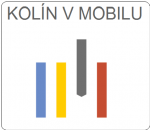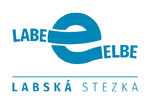II. From the cemetery to Práchovna (Powder tower)
We finished the first walk at the Jewish cemetery, so we will continue from there and we will set off to the other bank of the Labe.
After walking a few tens of metres from the cemetery we will get to the railway Kolín – Praha which we will cross using the new spiral footbridge. It will lead us to Kmoch´s Island which bears the name of thee famous composer and bandleader František Kmoch who is commemorated with a bust by Jan Drobník.
After the complete renewal the island is used not only for relaxing but also as a venue of concerts and other cultural events thanks to the newly built amphitheatre.
From the island you can use the footbridge over the Labe which was finished in 2005 which made the way to Zálabí easier for both pedestrians and cyclists. From the footbridge there is a beautiful view of the river.
On both banks (practically opposite to each other) there are buildings of two mills which were mentioned in historic sources already at the end of 13th century. In past both mills changed their name several times, at present they are called according to the names of the last owners – Formánek´s mill on the left bank and Radimský´s mill on the other one.
Behind Masaryk´s bridge (finished in 1927 according to the plan of Františk Roith) we can see the 120-metres high chimney of the Kolín power station. In the 1930s the chimney used to be the highest brick chimney in Central Europe.
After a few tens of metres from the footbridge we will see the home of local ice-hockey players – the ice-hockey arena. This originally uncovered ice rink was ceremonially opened in 1955. The arena was roofed at the end of 1970s.
Nearby on the river bank we can admire a prism late gothic stone tower called Práchovna (Powder tower). It was built in the first half of the 15th century and there was originally another fortification which was not preserved. In 16th and 17th century it was also used as a guarding tower from which it was possible to monitor the transport on the Labe. Later, the tower served as a warehouse of gunpowder which led to its name. During 19th century the tower lost the roof and it became run-down. After the reconstruction in 2006, the tower was opened to public as a view point thanks to the Town Information Centre.
Author: David Bárta
























 Máte zájem dostávat nejnovější zprávy přímo do vaší e-mailové schránky?
Máte zájem dostávat nejnovější zprávy přímo do vaší e-mailové schránky?